Argentina
Things to DO
Ushuaia
Tierra del Fuego
Located at the southern tip of South America, the Tierra Del Fuego archipelago includes one large island (48.100km2) in size, and a series of smaller ones.
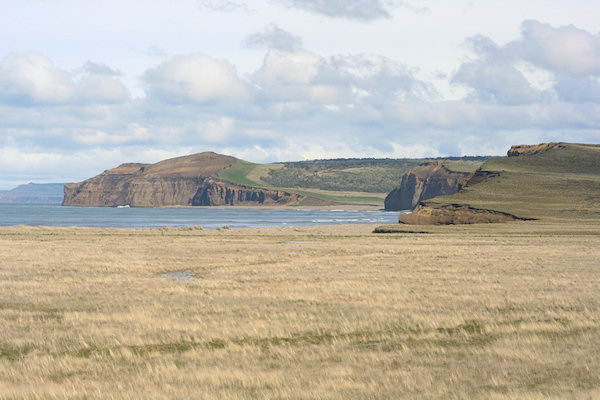 |
|||||
"Tierra del Fuego" (Spanish: "Land of Fire") got its name from Ferdinand Magellan
who, on passing the archipelago in 1520, spotted a number of fires burning along the coastline. These fires
may have been made by the archipelago's aboriginal inhabitants: the Ona, Alakaluf and Yahgan (commonly
called Yamana).
Four aboriginals were taken from Tierra del Fuego in 1830 by Robert Fitzroy, and were sailed to
Britain to meet the King. The three survivors later returned to Tierra del Fuego on the Beagle, with
Charles Darwin. The arrival of missionaries, introduction of sheep farming and the discovery of gold
in the 1880s led to European, Argentine, and Chilean immigrants, which gradually killed off the native
Fuegans.
An excellent book on the history of the Yamana and their demise is "Savage, The Life and Times of
Jemmy Button" by Nick Hazelwood.
See my
Things to Read page for more information
Today, the economy is based on petroleum, tourism, textiles, electronics and, to a decreasing degree,
sheep-farming.
The City
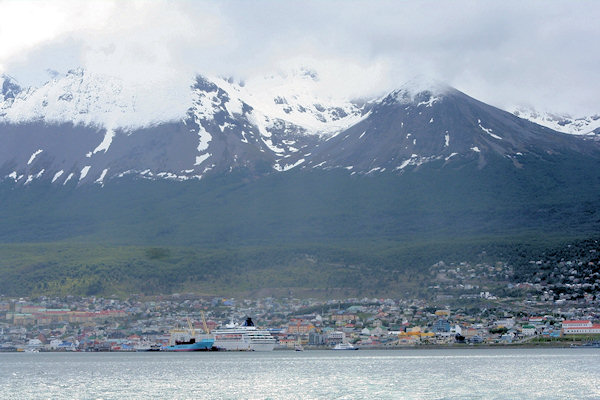 |
|||||
Set between the Beagle Channel and jagged glacial peaks rising from sea level to nearly 1.500 m.,
Ushuaia, boasts a dramatic location that few places can match.
But one is tempted to say Ushuaia boasts a little too much of its "World's End" status; yes, it is
the southernmost city in the world, but the relentless marketing of this superlative runs the risk of
overpowering the very remoteness it aims to promote.
Since 1950 the town has been an important naval base. industries such as electronics assembly, with higher
wages and other perks, encouraged people to settle here, which in turn resulted in a jumble of housing
devolopment
As the most important gateway to Antarctica, port for cruising yachts and coveted destination for
belt-notching travelers, Ushuaia caters well to the growing numbers of tourists, offering myriad activities
in and around town, and enjoys a national park for neighbor.
Military Prison
Construction of the "Presidio Nacional" began in 1902 and finished in 1920.
Labour was supplied by the prisoners themselves. In 1920, the Penitentiary had 5 pavilions with 76 external
cells each. The 386 cells were all designed for the occupancy of only one prisoner, but the penitentiary at
one point had some 600 inmates.
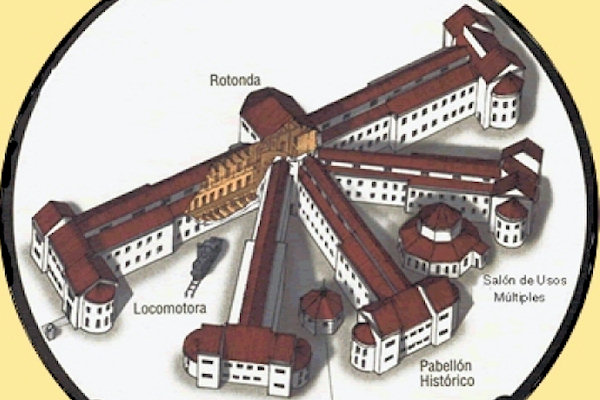 |
|||||
The kitchen was set up between Pavilion 1, otherwise known as the "Historic Pavilion" and Pavilion 2, and
the bakery was set up between pavilions 1 and 5. The workshops were located in separate buildings.
It was only in 1943 that a modern hospital established on the premises. This hospital was later to become
the Naval Base Hospital and for a long time it was to be the only one in the area.
The Central hall, or "Multiple Rotunda" was used as a conference room, movie theatre and auditorium.
Numerous delinquents who had committed serious crimes came to be incarcerated here through the course of
time, some serving life imprisonment and others serving considerably long sentences. Inmates were paid for
their work, elementary-school education was offered and severe discipline was the norm.
Inmates were taken off the premises as a source of manual labour in tasks such as the construction of
streets, bridges, buildings and obtaining lumber. This is how, in 1910, the southernmost train in the world
came to be built. It was 25 km. long and its route followed alongside Maipú street, passing by the camp at
Monte Susana and dividing in two separate routs, heading towards what is nowadays the National Park.
In 1947, with the change in designation from National Territory to a Maritime State, the National Presidency
declared the closure of the penitentiary. The installations were transferred to the Marine Ministry and a
Naval Base was established in it in 1950.
Today it houses Museo Maritimo de Ushuaia.
Museo Maritimo de Ushuaia
In the building of the former Prison of Ushuaia the director Carlos Pedro Vairo created
the Maritime Museum of Ushuaia, the Prison Museum, the Antarctic Museum José María Sobral, and the
Marine Art Museum of Ushuaia.
The Maritime Museum of Ushuaia:
Based on a collection of models and naval models and with a maritime background, this museum depicts
every aspect of the history of Tierra del Fuego from the particular point of view of seafarers.
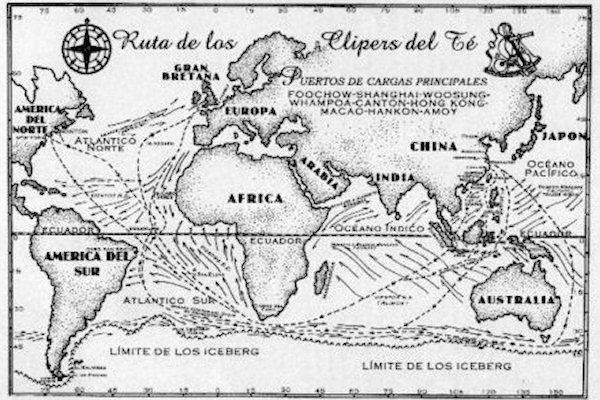 |
|||||
The Museum of the Prison of Ushuaia:
By visiting Pavilion IV, you will get to know the first Prison of Tierra del Fuego (1896), the project to
set up a Penal Colony, and the construction of the present building.
The Antarctic Museum José María Sobral:
Located on the first floor of Pavilion IV, this museum comprises 19 rooms covering the richest Antarctic
historic and biological heritage preserved.
To discover Ushuaia and its history, visitors are welcome to the second floor of Pavilion II
to enjoy:
• Photo exhibit about the evolution of the town of Ushuaia
• Gold seekers exhibit covering historical and present aspects
• Exhibit showing the southern urban architectural heritage (by Architect Leonardo Lupiano)
• Pioneers and first settlers – This is a series of rooms (former cells) showing various aspects of
European settlers in Tierra del Fuego.
The Marine Art Museum of Ushuaia unfolds its collection on the second floor of Pavilion III.
The exhibit is made up of a selection of works aimed at showing a balanced overview of the development of
marine art in Argentina from 1889 to the present.
Acuario Ushuaia
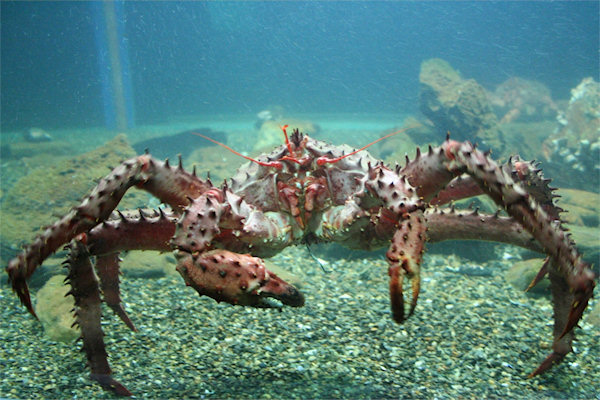 |
|||||
The idea of the creation of an aquarium emerged from a group of researchers from the Tierra del Fuego
Sea Biology Center, interested in spreading knowledge about sea life in sub-antarctic ecosystems.
After recycling the facilities of the old fishing plant, a multidisciplinary team of biologists, engineers
and safety counselors designed the aquarium, which recreates the sub-antarctic life conditions.
At present, local anglers and diving teams contribute with the growth of the aquarium population,
providing specimens they catch during their daily activities.
In the first tanks, we can observe stars and other echinodermata such as the sea urchins and sea
cuccumbers.
In the next tanks, we found several crustaceans such as the spider crab, with its long limbs, and the
lobsters, such as the munida gregaria and the subrugosa, with large claws, as well as chitons and
toritos.
The aquarium is completed with a submarine photographic exhibition done by photographer and diver
Héctor Monsalve, as well as an exhibition of bone remains of submarine animals.
Estancia Harberton
Ninety kilometers east of Ushuaia, on National Route Nº3, may be found Tierra del Fuego's oldest ranch:
Estancia Harberton.
Its founder, Thomas Bridges made his first trip to Tierra del Fuego,
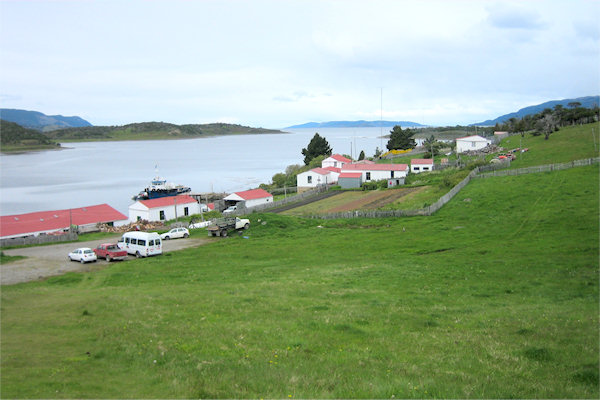 |
|||||
in 1863. He founded the Anglican
Mission at Ushuaia in 1870, establishing there permanently with his wife, Mary Ann Varder, and
their small daughter Mary, in 1871.
In 1884, he received the first Argentine expedition to Tierra del Fuego, which set up the subprefecture at
Ushuaia. Two years later, Bridges received Argentine citizenship and a donation of land from the Argentine
National Congress under Julio A. Roca in acknowledgement for his work with the natives and with shipwrecked
sailors of the Cape Horn area. It was named Harberton after his wife’s birthplace in Devon, England and was
the first productive enterprise in Tierra del Fuego (earlier enterprises, such as sealing, whaling and gold
digging, were all exploitive).
Harberton now belongs to the grandchildren of Thomas Bridges' sons Will and Lucas. Its manager, Thomas D.
Goodall, is a fourth generation great-grandson of the founder, and lives at the estancia in the original
1887 house with his family, members of the fifth and sixth generations.
Declared an Argentine National Historical Monument in 1999, the estancia maintains its original simple
buildings of wood covered with corrugated iron, its gardens, stone piers, and terraces.
Originally operating with sheep (for wool), cattle (for meat), Harberton also had the first almacén (store)
and imported supplies for all of southern Tierra del Fuego, as well as selling vegetables, meat and supplies
to the gold miners of the era.
Yécapasela Reserve
The Haberton estancia, which covers 50.000 acres of mountains, forests, lakes and islands, has, since the opening of the road in 1978, been managed as a working nature reserve. Two parts of the reserve are special: 'The Park' at the homestead, which has been fenced since the 1890s, and Isla Yécapasela (the native name; it is Isla Martillo on the maps) and its surrounding islands in the Beagle Channel.
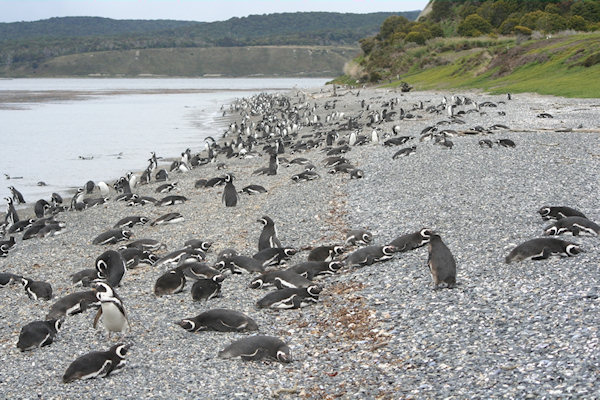 |
|||||
Originally used by the Bridges family for sheep and even cattle (forming instant fields
in the early days), these were removed in the 1960s and penguins have resettled on Yecapasela.
Yécapasela has a colony of 2000 pairs of Magellanic Penguins (Spheniscus magellanicus), 10 pairs of
Gentoo Penguins (Pygoscelis papua)- the only rookery in continental Argentina - and 125 pairs of
Rock Cormorants (Phalacrocorax magellanicus) nest on the cliffs to the south.
This penguin colony, the only one reachable from Ushuaia, is growing gradually each year. Yécapasela is a
great habitat for these penguins, as there are very few predators in the area, abundant food and the ground
and vegetation provide adequate shelter for nests and chicks.
For safety reasons people are only allowed to walk on the island with a specialized tour guide, in a
limited area and under very specific rules. These trips (15 minutes by boat each way, one hour on the island)
leave only from the Harberton homestead.
Beagle Channel
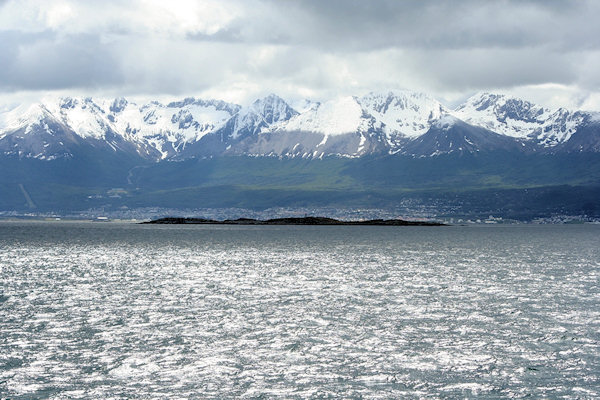 |
|||||
The Beagle Channel, peppered with picturesque inlets and bays, separates Puerto Williams,
Chile from Ushuaia, Argentina. 150 miles long and three miles wide.
Many people attest that sailing is the best way to experience the Beagle (particularly in autumn). There
are several options for boats that leave from Ushuaia-- including catamarans, motorboats, or sailboat -
and many companies that offer exciting half or full day tours.
The channel is surrounded by the Martial Mounts to the west and the Cinco Hermanos (Five Brothers) to the
east, which makes for a spectacular view of sea, sheer rock and glaciers.
Most boats head southwest to the center of the Beagle Channel for a view of the Les Eclaireurs
Lighthouse, where you can observe parts of the shipwrecked boat Monte Cervantes, which
met its fate in 1930.
Another island worth viewing is Los Pajaros (Bird Island), where more than 20 different species of
seabirds reign, including cormorants, petrels, squas and albatross.
Tierra del Fuego National Park
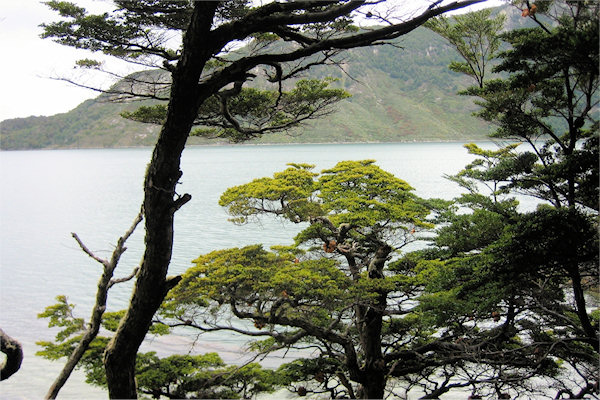 |
|||||
Created by the Argentine government in the year 1960 to protect the southernmost sub-Antarctic forests,
Tierra del Fuego National Park is the country's only park with an ocean shoreline.
With an area of 63,000 hectares, this National Park is situated in the southwestern area of Tierra del Fuego,
along the international border with Chile to the West and the Beagle Channel to the South.
It boasts a typical glacial landscape, with a mountainous area and deep valleys washed by rivers and lakes,
and mountains ranging from the North West to the South East.
On the coastal area, Lapataia and Ensenada bays intercalate cliffs and small beaches which offer the ideal
environment for the coastal bird fauna.
Lenga and coihue forests cover the most humid regions and the coast of the Beagle Channel.